Input interpretation

1, 1'-bicyclopentene
Basic properties
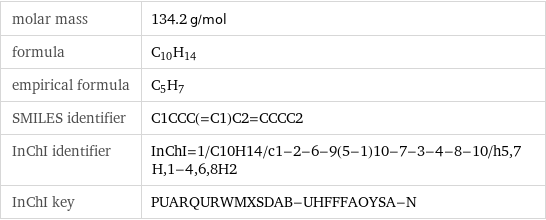
molar mass | 134.2 g/mol formula | C_10H_14 empirical formula | C_5H_7 SMILES identifier | C1CCC(=C1)C2=CCCC2 InChI identifier | InChI=1/C10H14/c1-2-6-9(5-1)10-7-3-4-8-10/h5, 7H, 1-4, 6, 8H2 InChI key | PUARQURWMXSDAB-UHFFFAOYSA-N
Lewis structure
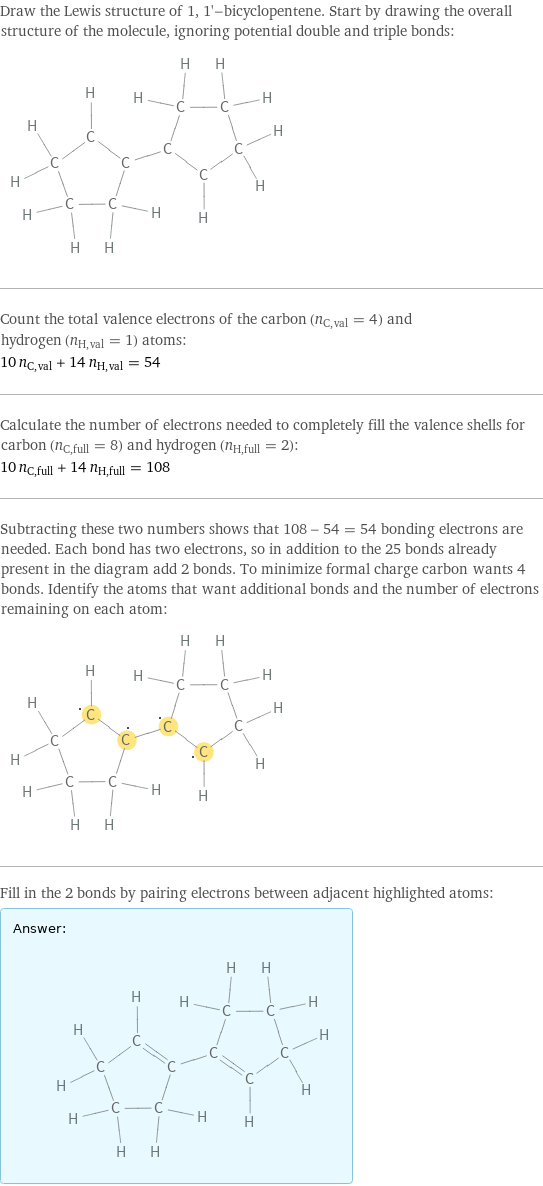
Draw the Lewis structure of 1, 1'-bicyclopentene. Start by drawing the overall structure of the molecule, ignoring potential double and triple bonds: Count the total valence electrons of the carbon (n_C, val = 4) and hydrogen (n_H, val = 1) atoms: 10 n_C, val + 14 n_H, val = 54 Calculate the number of electrons needed to completely fill the valence shells for carbon (n_C, full = 8) and hydrogen (n_H, full = 2): 10 n_C, full + 14 n_H, full = 108 Subtracting these two numbers shows that 108 - 54 = 54 bonding electrons are needed. Each bond has two electrons, so in addition to the 25 bonds already present in the diagram add 2 bonds. To minimize formal charge carbon wants 4 bonds. Identify the atoms that want additional bonds and the number of electrons remaining on each atom: Fill in the 2 bonds by pairing electrons between adjacent highlighted atoms: Answer: | |
Estimated thermodynamic properties
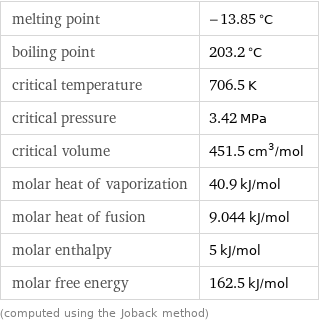
melting point | -13.85 °C boiling point | 203.2 °C critical temperature | 706.5 K critical pressure | 3.42 MPa critical volume | 451.5 cm^3/mol molar heat of vaporization | 40.9 kJ/mol molar heat of fusion | 9.044 kJ/mol molar enthalpy | 5 kJ/mol molar free energy | 162.5 kJ/mol (computed using the Joback method)
Units

Quantitative molecular descriptors
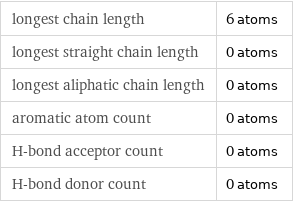
longest chain length | 6 atoms longest straight chain length | 0 atoms longest aliphatic chain length | 0 atoms aromatic atom count | 0 atoms H-bond acceptor count | 0 atoms H-bond donor count | 0 atoms
Elemental composition

Find the elemental composition for 1, 1'-bicyclopentene in terms of the atom and mass percents: atom percent = N_i/N_atoms × 100% mass percent = (N_im_i)/m × 100% Plan: • Write the chemical formula and gather atomic masses from the periodic table. • Determine values for N_i, m_i, N_atoms and m using these items. • Finally, compute the percents and check the results. Write the chemical formula: C_10H_14 Use the chemical formula to count the number of atoms, N_i, for each element and find the total number of atoms, N_atoms, per molecule: | number of atoms C (carbon) | 10 H (hydrogen) | 14 N_atoms = 10 + 14 = 24 Divide each N_i by N_atoms to calculate atom fractions. Then use the property that atom fractions must sum to one to check the work: | number of atoms | atom fraction C (carbon) | 10 | 10/24 H (hydrogen) | 14 | 14/24 Check: 10/24 + 14/24 = 1 Compute atom percents using the atom fractions: | number of atoms | atom percent C (carbon) | 10 | 10/24 × 100% = 41.7% H (hydrogen) | 14 | 14/24 × 100% = 58.3% Look up the atomic mass, m_i, in unified atomic mass units, u, for each element in the periodic table: | number of atoms | atom percent | atomic mass/u C (carbon) | 10 | 41.7% | 12.011 H (hydrogen) | 14 | 58.3% | 1.008 Multiply N_i by m_i to compute the mass for each element. Then sum those values to compute the molecular mass, m: | number of atoms | atom percent | atomic mass/u | mass/u C (carbon) | 10 | 41.7% | 12.011 | 10 × 12.011 = 120.110 H (hydrogen) | 14 | 58.3% | 1.008 | 14 × 1.008 = 14.112 m = 120.110 u + 14.112 u = 134.222 u Divide the mass for each element by m to calculate mass fractions. Then use the property that mass fractions must sum to one to check the work: | number of atoms | atom percent | mass fraction C (carbon) | 10 | 41.7% | 120.110/134.222 H (hydrogen) | 14 | 58.3% | 14.112/134.222 Check: 120.110/134.222 + 14.112/134.222 = 1 Compute mass percents using the mass fractions: Answer: | | | number of atoms | atom percent | mass percent C (carbon) | 10 | 41.7% | 120.110/134.222 × 100% = 89.49% H (hydrogen) | 14 | 58.3% | 14.112/134.222 × 100% = 10.51%
Elemental oxidation states
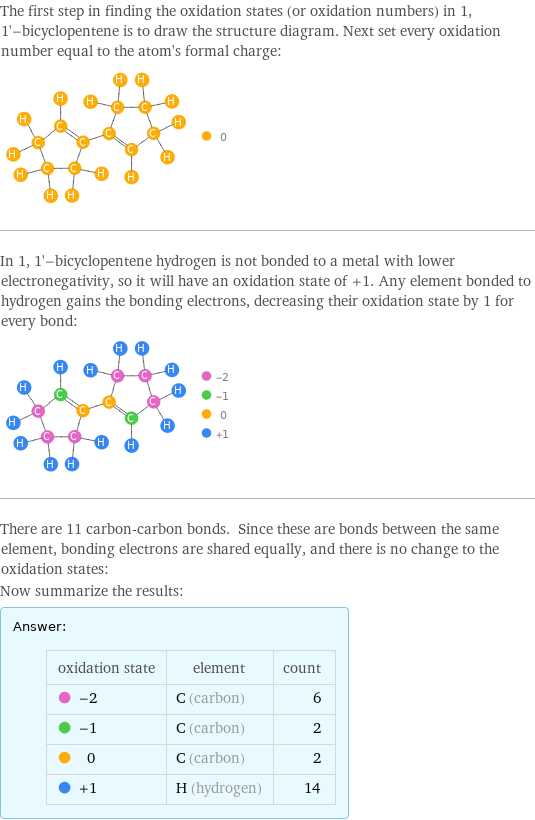
The first step in finding the oxidation states (or oxidation numbers) in 1, 1'-bicyclopentene is to draw the structure diagram. Next set every oxidation number equal to the atom's formal charge: In 1, 1'-bicyclopentene hydrogen is not bonded to a metal with lower electronegativity, so it will have an oxidation state of +1. Any element bonded to hydrogen gains the bonding electrons, decreasing their oxidation state by 1 for every bond: There are 11 carbon-carbon bonds. Since these are bonds between the same element, bonding electrons are shared equally, and there is no change to the oxidation states: Now summarize the results: Answer: | | oxidation state | element | count -2 | C (carbon) | 6 -1 | C (carbon) | 2 0 | C (carbon) | 2 +1 | H (hydrogen) | 14
Orbital hybridization
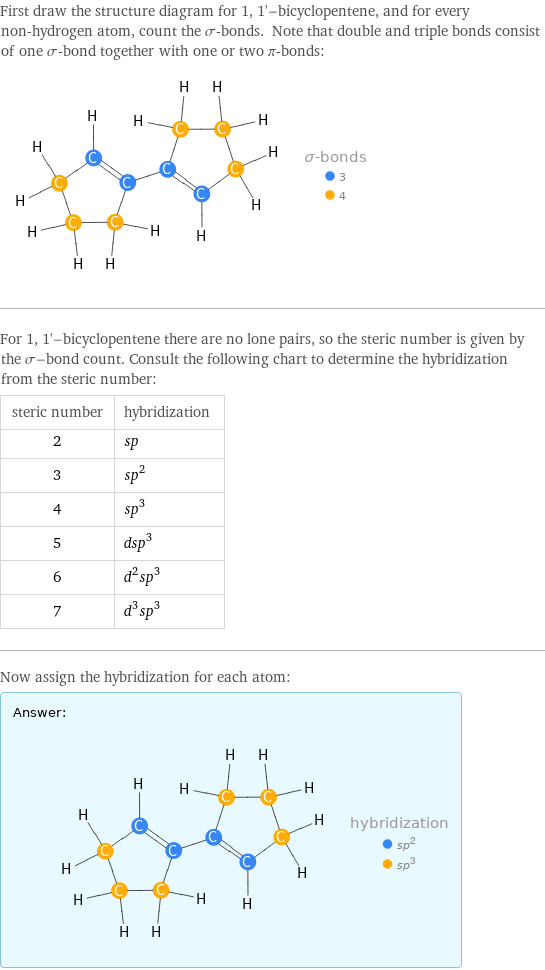
First draw the structure diagram for 1, 1'-bicyclopentene, and for every non-hydrogen atom, count the σ-bonds. Note that double and triple bonds consist of one σ-bond together with one or two π-bonds: For 1, 1'-bicyclopentene there are no lone pairs, so the steric number is given by the σ-bond count. Consult the following chart to determine the hybridization from the steric number: steric number | hybridization 2 | sp 3 | sp^2 4 | sp^3 5 | dsp^3 6 | d^2sp^3 7 | d^3sp^3 Now assign the hybridization for each atom: Answer: | |
Topological indices
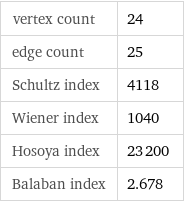
vertex count | 24 edge count | 25 Schultz index | 4118 Wiener index | 1040 Hosoya index | 23200 Balaban index | 2.678